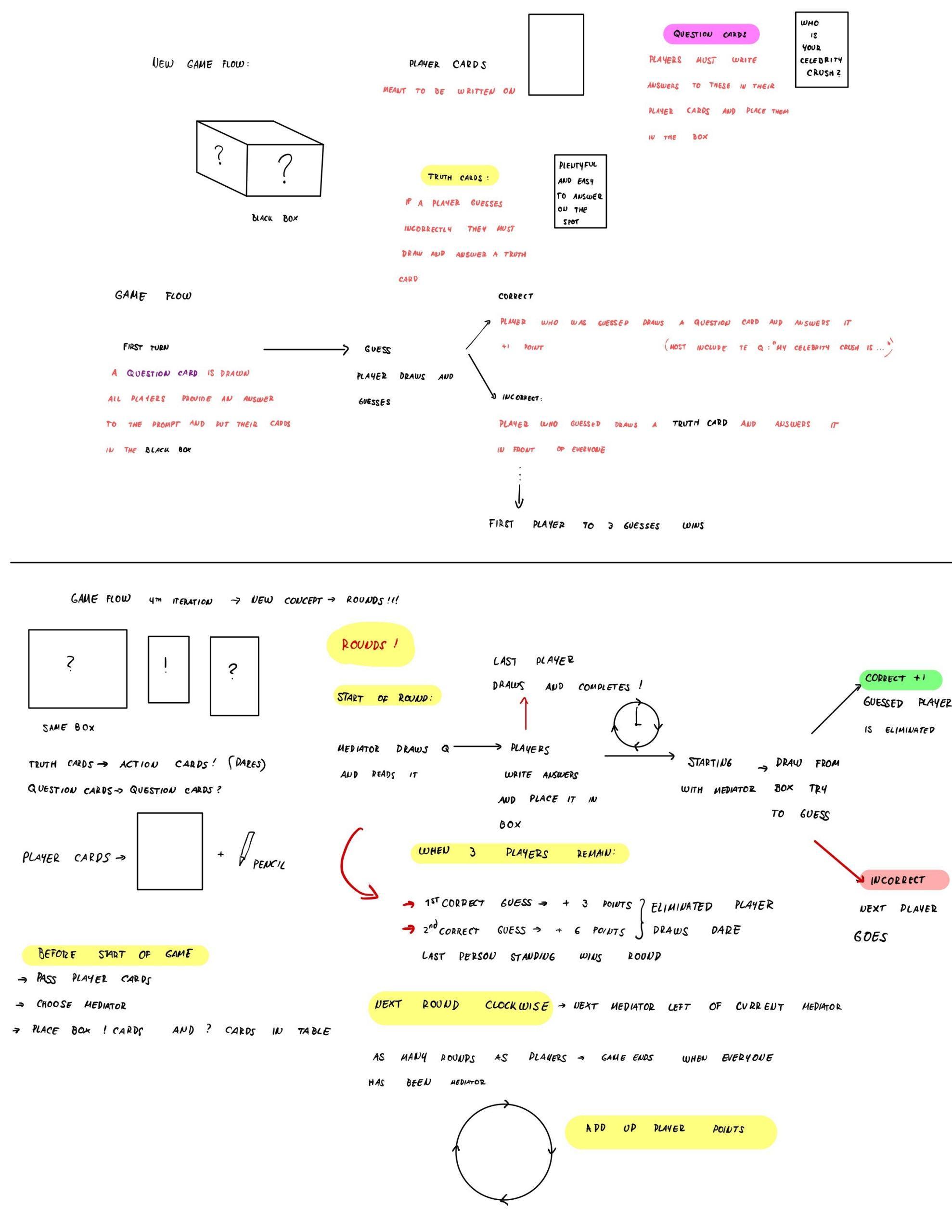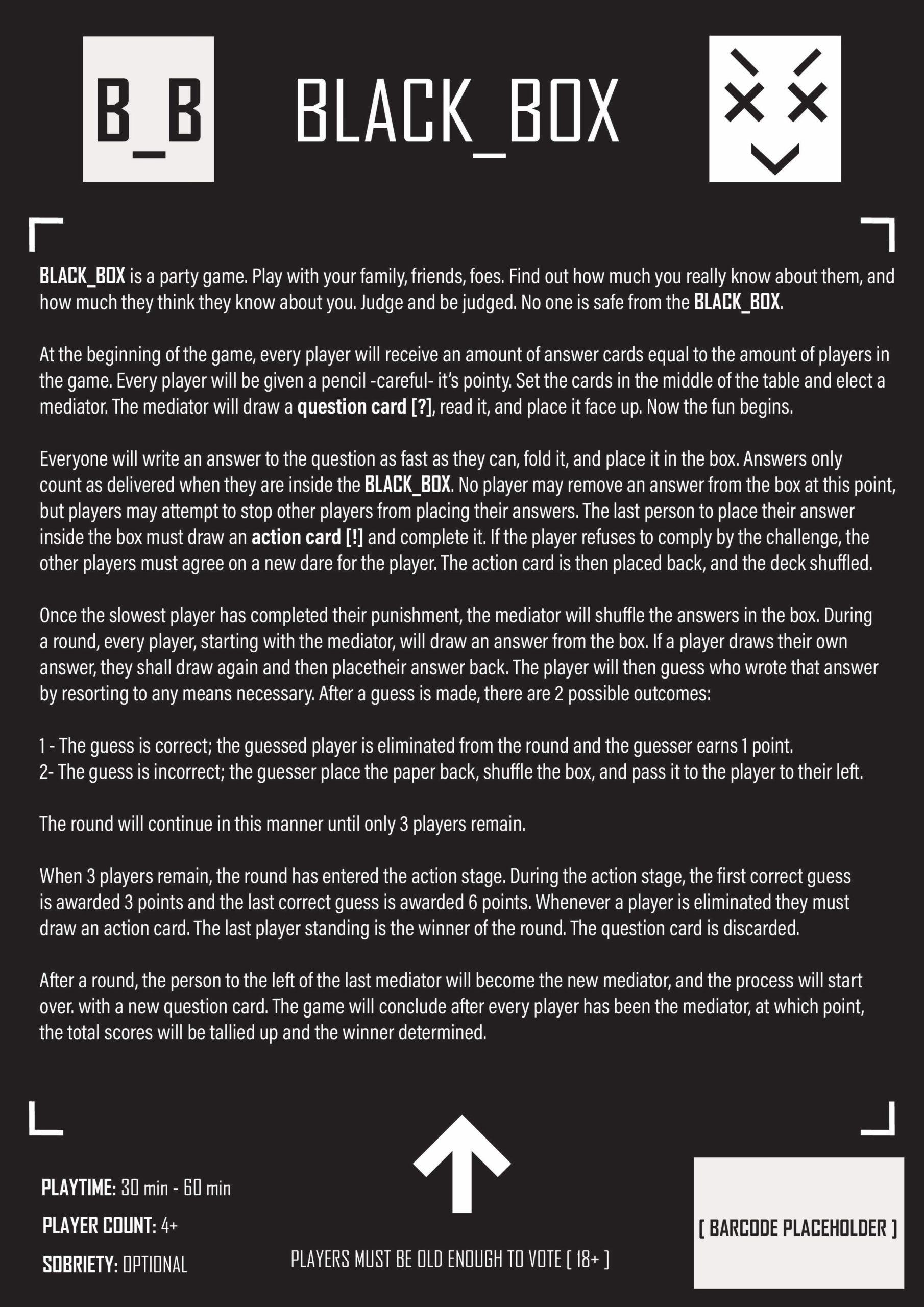Noel Sarduy, Will Coors, Ashley Chen, Walker Stewart
ARTIST’S STATEMENT:
Who is It is a multilaterally competitive party game designed for friends. Players answer prompted questions and take turns guessing who wrote what answers. Questions are intended to spark discussion and intrigue on exactly which people within a player group are most likely to answer what. We use mechanics of question-asking and answering as well as randomization and prediction. The ultimate objective of the game is to make social situations lively and bring people together. The game cultivates fellowship and discovery types of fun. The game generates fellowship through the player interaction that comes from the guessing and discussion caused by the game. Discovery is cultivated by giving players leeway to answer the prompts as they so choose, allowing others to learn more about them on their own terms. Ultimately, Who is It is a casual game with structure to make for a fun experience for all players whether they have never played the game before or play frequently.
CONCEPT MAP:

INITIAL DECISIONS:
Game Design Profile:
- Objective: Solution-Prediction (players must figure out whose secret is the one being drawn)
- Player number: 4+, the more the better, up to 10 or so.
- Roles: Players alternate between being the one that draws the cards and guesses who wrote the card, as well as the one that writes and completes dares
- Interaction/Competition Type: Multilateral competition (players take turns ‘pairing up’ unintentionally by drawing out cards and guessing, as well as issuing and completing dares
- Rules: Action rules (players go in a circle, players write out dares/secrets, players guess out what they think works)
- Boundaries: Emotional boundaries (players should temper their secrets based on how group norms (implicit or explicit) are set, as well as temper their dares to what would be immediately doable and not too intrusive)
Types of Fun:
- Fellowship: This is incorporated into the game by its nature as a party game- the game is a social framework for interacting with friends and learning more about them.
- Expression: This is incorporated through players generating secrets about themselves and challenges for players. They are able to shape the game.
Player Profile:
- Skill: knowing how to read and write
- Familiarity with genres: None- perhaps a comprehension that this is a casual, fast paced game, no real stakes involved (familiarity with party games)
- Platform preference: in person, card based, analog
- Play habits: playing with friends for >= an hour, alcohol would probably be involved
- Play styles: living room, table, dining room table, table in general
- How often: monthly- anytime people feel like it in general- not more than biweekly in general (requires new material)
- Fit: party game that connects people, everyone is familiar with each other but wants to get to know each other more
Gameplay:
Our initial gameplay (rules and procedures) is found here.
TESTING AND ITERATION HISTORY:
PLAYTEST v1.0
- Who playtested: Our group
- What we are testing: The ‘base’ level game (Pizza Box) that we are using as inspiration for the design of our game.
- Gameplay: You start with a flattened out cardboard box and draw player’s names using a pen and circle them. Players take turns flipping a coin. If the coin lands on a player’s name, that player completes a previously decided upon action, and if it lands on an empty space, that player generates a rule for other players to follow.
What went well:
- Created fun atmosphere where game facilitated interaction rather than being the center of it
- Challenges were fun and could scale to familiarity of group
What could be improved:
- There was a lot of empty time at the start of the game when the coin landed on empty space or didn’t land on the box.
- People had difficulty generating challenges on their own
Refinement: Incorporate another dimension to the game on top of challenges to improve play at the start of the game (we thought of having players generate secrets to start the game).
Questions Generated:
- What is an ideal pace for the game? How can we find the most engaging balance between rewards and punishments?
- How can we make the pattern of the game as unpredictable as possible with cards and challenges? Any other randomization strategies?
PLAYTEST v2.0 (our initial game)
- Who playtested: Group of students in section. Most students knew each other and were friends outside of class.
- What we are testing: Want to make the game more engaging at the beginning through the implementation of secrets. We wanted to discover if adding secrets was a favorable element.
- Gameplay: People wrote down a secret about themself (no prompt), and placed cards on the table. Players would take turns guessing who the secret belonged to, and if they guessed correctly, they would generate a challenge to place on the table and the person whose secret was guessed generated another secret to place in the box. If a player drew a challenge, they would perform the task and replace.
What went well:
- Seems to facilitate good group interactions and conversation outside of the game
- Ex. There was a secret “I am from Kansas”. This created a few minutes of positive conversation that paused the game but was fun for participants.
- People were laughing and did seems to enjoy
- Playtesters enjoyed the idea of a secret game
What could be improved:
- Twice people drew their own secret
- Challenges repeated
- Idea that people liked: When you do a challenge, you get to either choose to replace it or come up with a new challenge of your own
- Organization of cards is difficult
- Shuffling was difficult
Refinement: Find a better way to generate randomness in game and remove undo repetitiveness.
PLAYTEST v3.0
- Who playtested: Group of 5 students in class. Students did not know each other very well.
- What we were testing: Does the randomness of using a box improve the randomness? Are pre-written cards (opposed to student generated) better?
- Gameplay: Students put secrets in a box, dares were prewritten. Turns move around the circle, and players take turns guessing. When someone gets the correct answer, a dare card is added to the box and the student adds a new secret to the box. Game repeats until time runs out.
What went well:
- Gameplay was smoother than previous playtests
- Good balance of correct/incorrect guesses
What could be improved:
- Prompt for question
- Somewhat bland secrets from some players
- Weird dynamic with both secrets and challenges in the same box
Refinement: Separate secrets and challenges. Have pre-generated questions and challenges for players to facilitate fun answers and reduce waiting time of players generating content.
PLAYTEST v4.0
- Who playtested: Group of students in class. Students did not know each other very well as a whole group, but a many sub-groups were friends.
- What we were testing: Do pre generated questions (as opposed to random student generated secrets) improve the game? Is it better to give challenges upon some milestone being achieved in the game rather than mixing with secrets?
- Gameplay: One question to start. Everyone writes an answer and puts it into the box. People take turns guessing. When someone matches the answer to a question, the person whose answer it is picks from a pile of challenges, and performs the action on the card. A new question is then drawn, and players generate new answers. Repeat from above.
- Game Art: Here is a LINK to game art we generated for this version.
What went well:
- If you guess right, reward for guessing correct having the player do a challenge
- Fun/funny answers from players
- Helpful to have a mediator to keep the game flowing
What could be improved:
- Poor challenges messed with pace of gameplay. Challenges that required significant movement from spaces or long challenges were awkward
- Were a few times when it took a long time for a player to submit an answer to a question
- Absolute questions were uncomfortable to answer (e.g. worst, best, first)
- Some players were advanaged by their position, and questions were frequently discarded because people were good at guessing who the answer belonged to.
Refinement: Rework some challenges and questions according to the notes above (remove absolute questions, rework cumbersome challenges). Retool gameflow to increase fairness and continuity in gameplay. Update the game art to be a better reflection of the game.
A video of our final playtest is here.
FINAL PROTOTYPE:
All materials required for gameplay and a print-and-play of our final prototype is here.
DESIGN MOCKUPS:
BOX FRONT:

BOX REAR:

CHALLENGE CARD BACK

QUESTION CARD BACK




